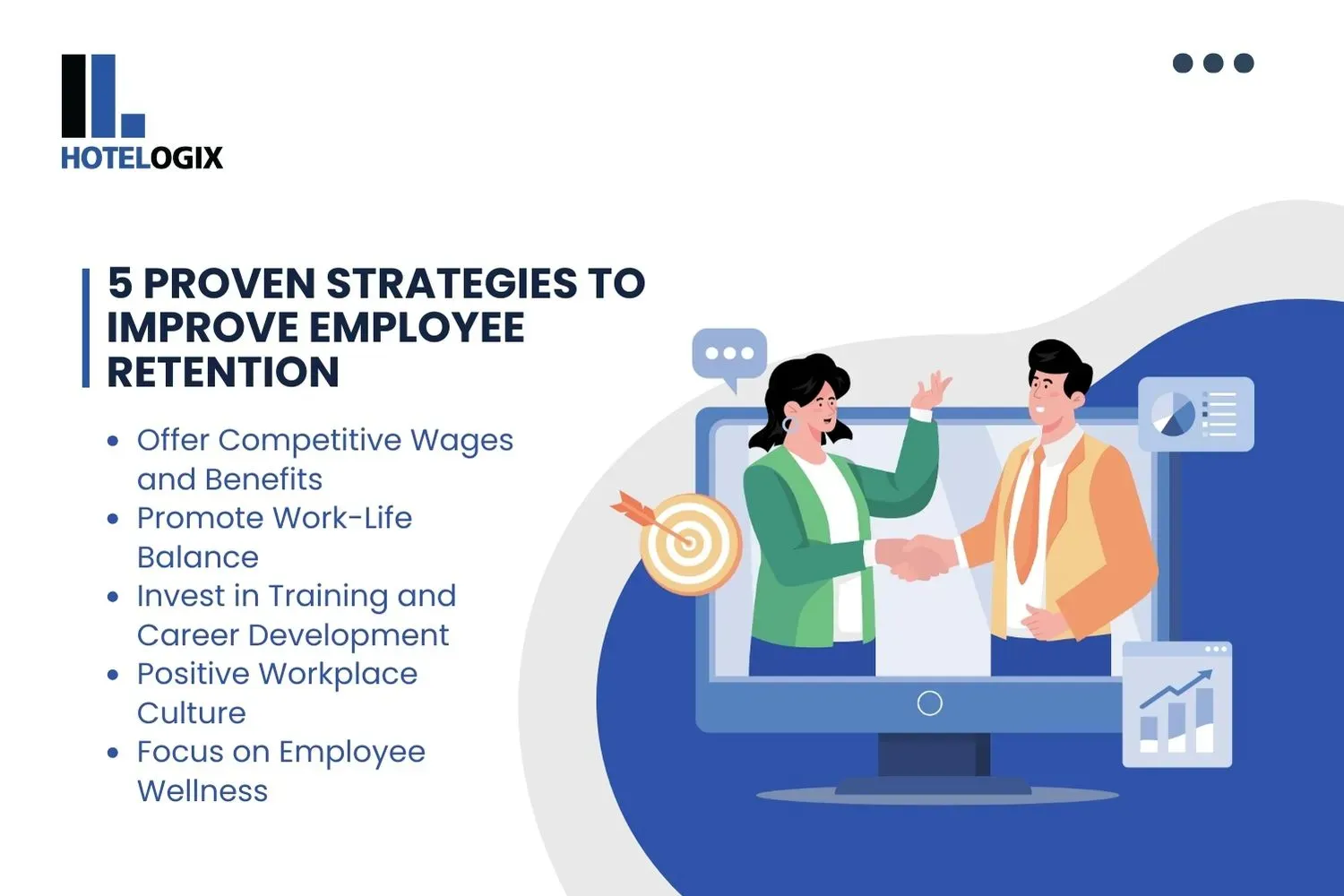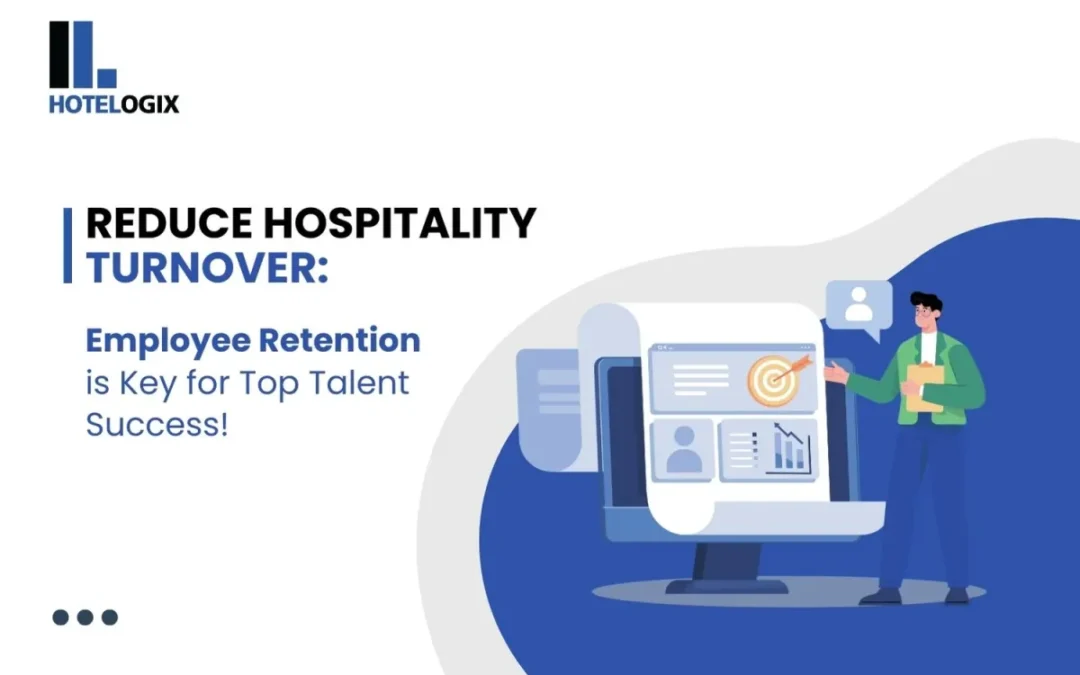Did you know that the hospitality industry is facing an alarmingly high employee turnover rate? In 2021, the leisure and hospitality sector in the USA experienced a turnover rate of 84.9%, significantly higher than the national average of 47.2%. (Hospitality Net)
This constant churn not only disrupts operations but also incurs substantial costs. Replacing an employee can cost between 50% to 200% of their annual salary.
It is not merely an HR matter for hotel owners and managers; it is a deep business concern. Turnovers greatly affect customer satisfaction, wire workflows, and erode budgets. But there are proven ways to better retain employees, reduce expenses, and create a more motivated team. This blog helps identify why staff members leave, how to retain them, and how technology, such as that provided by Hotelogix, can aid in creating a loyal workforce.
The Importance of Employee Retention in Hospitality
Why Retention Matters
In hospitality, employees are the heart of the business. From front desk staff to housekeeping, every team member contributes to the guest experience. High turnover can mean inconsistent service, longer wait times, and frustrated customers.
The Cost of Losing Staff
The financial implications of turnover are significant. Studies indicate that replacing an employee can cost between 50% to 200% of their annual salary.
This includes recruitment and training costs and the loss of productivity during the transition period. When spread over several employees, it is clear how high staff turnover can eat into profits.
Guest Experience
Changing staff often will confuse guests, reduce service quality, and damage your hotel’s reputation. Happy employees create happy guests—a perfect win-win situation for all.
Causes of High Staff Turnover
The first step to solving employee turnover is to understand why people leave a job. Here are some of the most common challenges hotels face:
Low Wages and Limited Benefits
Hospitality jobs are often low-paid and offer minimal benefits. Workers feel unappreciated, so they are more likely to move on to other better-paying jobs. If pay and benefits, such as health insurance or retirement plans, are competitive, this would make a huge difference. Without these, many workers feel they are not paid enough for the level of work they are doing.
Long Hours and Unpredictable Schedules
Late-night shifts, split schedules, and long hours of work can burn out the most dedicated worker. Hospitality jobs often require working on weekends, holidays, or odd hours. This can disrupt lives in addition to physical and mental exhaustion. Scheduling flexibility and having enough rest between shifts remain a major improvement in retaining employees.
Lack of Career Advancement
Many employees leave because they do not see a future in their jobs. Without a clear career path, they are stuck in a dead-end job. Training and leadership development opportunities along with a transparent career progression plan can help them stay longer in the organization since they see a future within it.
Constant Manager Turnover
Instability in leadership can lead to unorganized teams and low morale. When managers leave frequently, the staff usually leaves with them. Managers set the tone for the workplace, and constant turnover disrupts the team dynamic, leaving employees feeling unsupported or undervalued. Investing in leadership development and promoting internal candidates can help reduce this issue.
Inadequate Training and Onboarding
New employees who feel not trained or supported will quit early. An inappropriate onboarding process may send the wrong signal for their entire experience. The lack of appropriate tools, guidance, and knowledge about the role may make them feel overwhelmed. A structured onboarding program and further training will build confidence in new hires and integrate them into the team.
Lack of Recognition and Appreciation
People who feel their hard work goes unrewarded tend to look elsewhere for appreciation. A simple “thank you” or recognition of effort goes a long way. Implementing reward systems, such as employee of the month programs or performance bonuses, will make the employees feel valued and appreciated.
The Real Cost of Employee Turnover
Financial Costs
Each time an employee leaves, hotels incur costs in advertising the opening, interviewing candidates, onboarding new hires, and training them to become productive. Studies estimate that the cost of replacing an employee can be anywhere from 16% to 20% of their annual salary. For example, if a mid-level employee earning $30,000 annually quits, the replacement cost could be as high as $6,000. These costs multiply with every turnover event, eating away at profits and straining HR budgets.
Operational Disruptions
The overall output of an under-staffed team suffers the most; as hotel operations gradually decrease, there may be front-desk queues with increased waiting hours, increased delays in housekeeping, and unattended or missing chores. Housekeeping, in one peak season example, was expected to clear many rooms, which required a good speedy change but resulted in dissatisfied guests in an already filled property. Apart from affecting service, understaffing may over-employ the other few employees working out, therefore experiencing higher levels of stress with the possibility of getting exhausted.
Challenges in Guest Experience
Guests quickly identify whether a hotel is understaffed. Delayed service, a missed room cleaning, or simply an inattentive staff can all be traced back to disruption caused by turnover. In a competitive market like today, bad reviews can give a hotel a black eye and keep guests away. Employee retention, therefore, is an indirect investment in guest satisfaction and loyalty.
5 Proven Strategies to Improve Employee Retention
So, how can you keep your staff happy and reduce turnover? Here are some actionable steps:

Offer Competitive Wages and Benefits
- Conduct salary benchmarking to ensure your pay is fair and competitive.
- Offer non-monetary perks like free meals, transportation, or wellness programs.
- Provide bonuses or incentives for excellent performance and loyalty.
Promote Work-Life Balance
- Implement flexible scheduling to reduce stress and improve morale.
- Limit excessive overtime, and give time off to recharge.
- Be prepared to offer counseling and stress management workshops.
Invest in Training and Career Development
- Provide regular training- skill building and boosted confidence
- Mentorship for the support of employees’ professional development
- Give clear paths for real career advancement – keep employees motivated to stay.
Positive Workplace Culture
- Publicly and privately reward hard work done.
- Open communication channels between employees and management.
- Create a team-based culture where each employee feels appreciated.
Focus on Employee Wellness
- Develop wellness programs, like exercise classes, yoga classes, or stress days.
- Allow employees to meet health experts for stress and burnout management.
- Help employees take time off and focus on their well-being.
How Hotelogix Can Assist in Retaining Employees
Automation of Repetitive Tasks
Technology can greatly decrease the amount of manual work, which is usually a source of frustration for employees. For example, Hotelogix automatically updates room inventory, billings, and report generation. When staff is relieved of this monotonous work, they have more time for guest interaction, which is satisfying and less stressful. A mid-sized resort that implemented automation reported a 30% decrease in staff complaints about workload.
Simplification of Scheduling and Shift Management
The most common pain point of hospitality employees is scheduling conflicts. Hotelogix’s scheduling tools allow managers to create fair and transparent shift schedules while enabling staff to request changes easily. For example, a chain of boutique hotels using Hotelogix reduced scheduling conflicts by 40%, leading to fewer missed shifts and higher employee satisfaction.
Seamless Onboarding with PMS
Hotelogix simplifies the onboarding process for new employees with intuitive interfaces and built-in training modules. For instance, a newly opened hotel in Miami used Hotelogix’s onboarding tools to train its staff, reducing the time to productivity from four weeks to just two weeks. Faster onboarding not only boosts confidence but also ensures new hires feel supported.
Real-Time Communication Tools
Effective communication is the key to a smooth operation. Hotelogix provides instant messaging and feedback-sharing tools, which help employees and management stay on the same page. For instance, a luxury hotel chain used these tools to implement a real-time feedback system, improving the time it takes to resolve issues by 50% and enhancing overall employee satisfaction.
Addressing Constant Manager Turnover
Leadership change may trickle down to the rest of the team and create instability. Here’s how to address it:
Leadership Development Programs
Investment in training in leadership will equip managers with the necessary skills for success. For instance, a global hotel brand rolled out a mentorship program for mid-management and saw retention of management increase by 20%. Good leaders not only motivate their teams but also bring stability to workplaces.
Promote From Within
Internal promotions are a strong retention tool. The more employees understand that opportunities exist, the less likely they will leave. One regional hotel chain instituted a “grow from within” policy, and within two years, turnover dropped by 15%.
Build Trust and Accountability
Trust is the foundation of any successful team. Regular check-ins, transparent communication, and consistent expectations help build a culture of accountability and mutual respect. For example, a boutique hotel implemented monthly one-on-one meetings between managers and staff, which improved team morale and reduced turnover by 10%.
Conclusion: A Roadmap to Employee Retention Success
Improvement of employee retention is a multi-pronged approach. Fair pay, good schedules, career growth, and work culture are what matter. However, technology is the real game-changer. With the adoption of the right hospitality management system, such as Hotelogix, you can automate your tasks, simplify operations, and bring a better work environment to your employees.
Invest in your staff, and they will invest in your guests. Ready to take the first step? Discover how Hotelogix can help your hotel reduce staff turnover and build a loyal, thriving workforce today.

